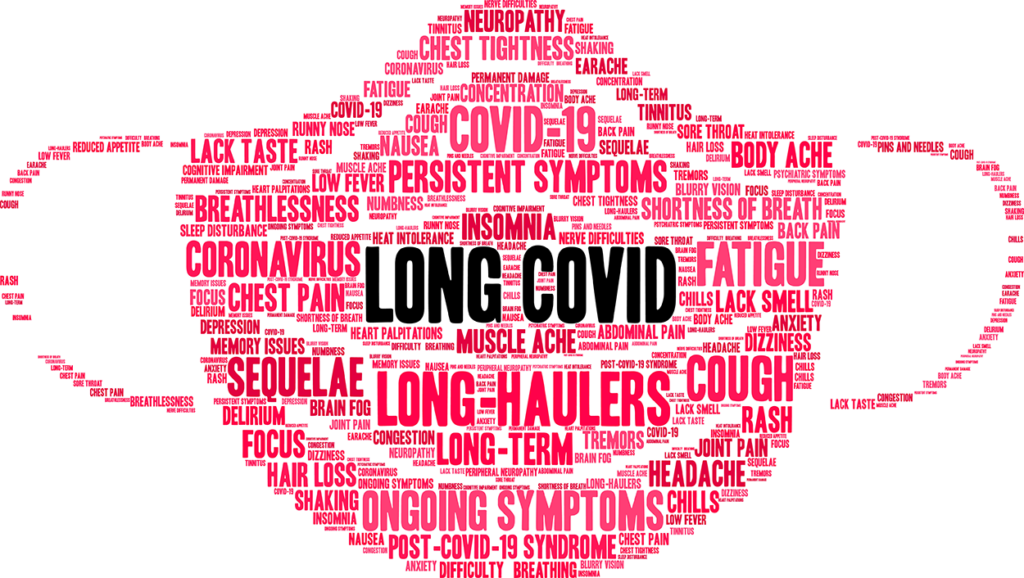The Trending With Impact series highlights Aging (Aging-US) publications that attract higher visibility among readers around the world online, in the news, and on social media—beyond normal readership levels. Look for future science news about the latest trending publications here, and at Aging-US.com.
—
Among people who have been fortunate to recover from COVID-19, at least 40% had or have long-term lingering effects from this disease. Frequently appearing months after recovery, these “long covid” effects can include (not limited to) fatigue, trouble sleeping, difficulty concentrating, joint or muscle pain, and respiratory issues, such as shortness of breath and chest pain. Researchers are still unsure as to whether or not lasting COVID-19 effects in the lungs are associated with the severity of disease at the time of infection.
“Thus, prospective studies related to outcomes following recovery from COVID-19 might improve our understanding of this disease, its sequelae, and possible interventions to improve this situation.”
Researchers—from Hospital Universitario San Pedro, Centro de Investigación Biomédica de La Rioja, Universidad de Córdoba, Hospital Universitario Reina Sofía, Hospital Costal de Sol, HCU Lozano Blesa, Hospital Universitario Marqués de Valdecilla, Unidad de Enfermedades Infecciosas, Hospital Universitario de Burgos, Vitro Laboratory, Instituto de Investigación-IdiPaz, and Universidad Rey Juan Carlos—conducted a new study aimed at identifying biomarkers of severe disease in patients after hospitalization for COVID-19. Their research paper was published by Aging (Aging-US) on February 16, 2022, and entitled, “Elevated levels of serum CDCP1 in individuals recovering from severe COVID-19 disease.”
The Study
A total of 108 recovered COVID-19 patients admitted to hospitals throughout Spain (46.2% of whom had severe cases) were enrolled in this study. Lung function was measured by the capacity to diffuse carbon monoxide. Samples of serum and induced sputum (phlegm) were collected from the patients and used to evaluate the relationships between patients with residual inflammation in the lungs. Within these samples, the researchers analyzed and compared the levels of 92 protein biomarkers, including various chemokines, cytokines, growth factors, interleukins, and the CUB domain-containing protein 1 (CDCP1)—a cell surface glycoprotein. High levels of CDCP1 were previously observed in some severe cases of COVID-19 in children.
“In COVID-19-infected children who developed acute vasculitis, CDCP1 was one of the most significantly upregulated genes [25], but this complication was not observed in our study.”
The Results
Of all 92 biomarkers, multivariate analysis showed only elevated levels of serum CDCP1 in individuals recovering from severe COVID-19. To their surprise, they also found a positive relationship between CDCP1 and TGFb1 in sputum samples (irrespective of severity). The researchers found a significant difference in lung function (as measured by diffusing capacity for carbon monoxide (DLCO)) between those who had severe cases of COVID-19 and those who had mild/moderate cases. Differences in serum proinflammatory cytokines were not observed between the two groups of recovered COVID-19 patients, indicating that these biomarkers subside after recovery. Correlations between serum and induced sputum levels were detected for only a few biomarkers.
“Independent predictors of severe disease were DLCO <80% and the serum CDCP1 value.”
Conclusion
The authors were forthcoming about the limitations of their study. The team did not use a control group, although, the goal of this study was to investigate the severity of COVID-19. The cohort was relatively small, and the researchers note the need to further study the role of CDCP1. They also suggest that prospective studies should follow patients in recovery from COVID-19 in order to continue improving our understanding of this still novel virus. Such information could aid in the development of interventions to improve patient prognoses long-term.
“In conclusion, although the long-term impact of high serum levels of CDCP1 is still unknown, we should be alert to the potential implications for lung disease. For this reason, it is necessary to follow such patients for longer periods of time to detect and adequately treat potential pulmonary sequelae.”
Click here to read the full research paper published by Aging (Aging-US).
AGING (AGING-US) VIDEOS: YouTube | LabTube | Aging-US.com
—
Aging (Aging-US) is an open-access journal that publishes research papers bi-monthly in all fields of aging research. These papers are available to read at no cost to readers on Aging-us.com. Open-access journals offer information that has the potential to benefit our societies from the inside out and may be shared with friends, neighbors, colleagues, and other researchers, far and wide.
For media inquiries, please contact [email protected].

